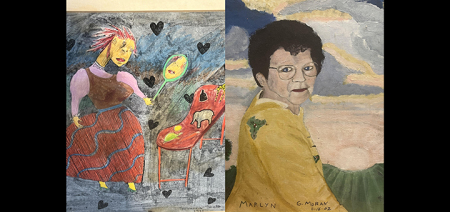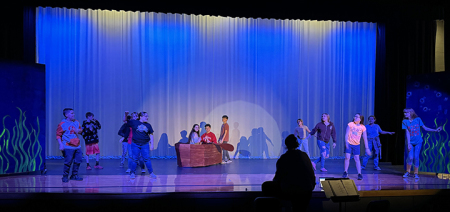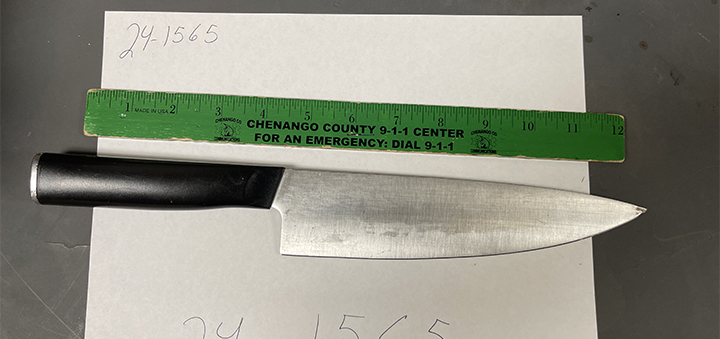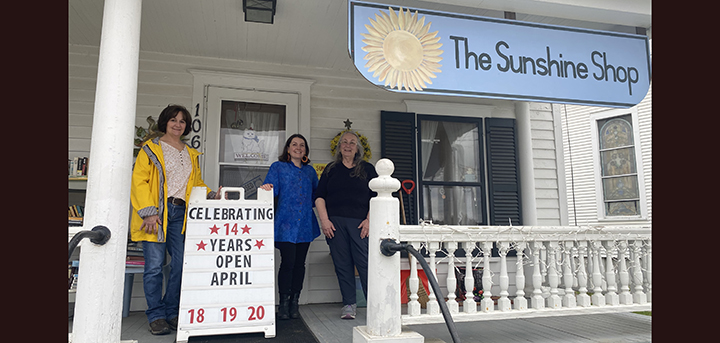Trip To Italy Part V: Giorgio
Published:
November 10th, 2006
By:
Mary Musson
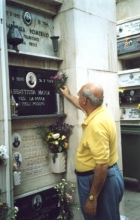
By Mary Musson
Correspondent
“Do you want to go to the cemetery to visit my mother?” says my cousin Mariella. Of course I do. She is referring to my Aunt Mimi, Dad’s favorite sister, recently dead at 91 and buried in this small cemetery in the suburban town of Arese, just outside of Milano. Hers is the last family grave I will visit before my return home to Norwich.
In my month-long visit to Molfetta, I had put in my cemetery time, a social requisite of all visiting expatriates. I had spent one morning with Zia Pina visiting the Pansinis, my mother’s family, and one morning with my cousin Sergio visiting the La Roccas, my Dad’s family. Both times I had brought mums and sunflowers and when we stopped at the flower mart to purchase them, I had asked Zia Pina how many flowers would suffice, how many dead were there? “Too many,” she answered, and she was right.
Oh, how the Italians love their dead! I read somewhere that if you really want to know a culture, visit their cemetery, and this visit to one of Molfetta’s most treasured holy grounds taught me a great deal about my clan. Like the rest of the people in this town, my family is very attentive to their dead, making sure that grandma and grandpa and aunts and uncles and babies who died too soon are never forgotten. They visit weekly and bring fresh flowers, and water jugs and clean rags to wipe down the marble markers. I am impressed by the tradition, but it was cousin Sergio’s affectionate ritual that really got to me. He would walk up to the tomb marker, touch his lips with his left hand, then touch the photo of his dear one leaving the imprint of his gentle kiss. He did this over and over again as we visited some 15 dead relatives, and each time the same ritual was performed with the intensity and honesty of real emotion.
I like this man. He is my cousin Lisa’s husband of almost 40 years and I still remember how impressive he was when he first took me to Molfetta Antica, the ancient 13th century town on the edge of town and gave me the history lesson of my life back when I was just 17 years old. He had done his doctoral dissertation on the ancient maritime systems of this part of Puglia and he was a walking reference book on the subject. He has that rare talent so few teachers have – he can make history come alive and send you back in time in a blink. Even on this cemetery visit, he does not disappoint. He explains that the dead in Molfetta are never embalmed. If there is a family tomb, they go there directly. Most, however, are buried immediately in a section of the cemetery where they remain for ten years underground, then they are dug up and their bones are ceremonially (with family in attendance) placed in an Ossario. These walls of small tombs we have been visiting contain my relative’s bones and are marked with their photo, date of birth and death, an eternal flame and a carved vase where I put my flowers. As we go walk around I imprint the family names to memory – Caputo, Abbatista, Silvestri, Minervini, Medina, DeCandia, Gadaleta, Allegretto, Tatulli, Valenti, Annese, Freda and Sergio’s own colorful name: Sciancalepore. I ask him its origin and he tells me of nicknames that become family names. His means “throw off a leopard,” no doubt some ancient family story about wrestling wild animals. Then he walks me around and points out other funny names: Settedenti (seven teeth), Cristoengud (Christ on your back), Messatadacetta (killer of birds), Boccanegra (black mouth) and my favorite Spaccavento (breaker of wind!). Over the years there have been many rifts in my proud and easily offended family, but actions speak louder than words and it is cousin Sergio who places fresh flowers at my paternal grandparents tomb every Sunday, and I respect him greatly for it.
As he stepped back and allowed me the honor of placing the flowers this time, I was dazzled by my grandmother’s picture. She is so beautiful – the clear skin, the large green eyes, the long hair plaited into two braids and crossed on top of her head like a small tiara. She lived a full life until age 87 and although stocky and a bit overweight, she was never sick a day in her life. I draw comfort from this because I am built just like her and have her eyes. I am sorry I never really got to know her or any of my grandparents and I think about how lucky my husband is to have had such fond memories of his grandparents, Mable and Ben Wilber and Arthur Musson of Gilbertsville. He speaks of them often and as American tradition suggests, once a year on Memorial Day we visit their graves, but it is not the same and once again as I draw these inevitable comparisons, I am glad to be Italian.
“We need to get off at the next bus stop to go to the cemetery,” cousin Mariella reminds me, and again I follow her in a muted trance. We have been touring the great city of Milano all day and I have not been the same since I saw its Duomo for the first time earlier in the day. Now, let me tell you that I have seen some great churches and cathedrals in my lifetime, but Milano’s Duomo took my breath away – no, actually, it made me cry. Such a big church, the third largest in Europe! It’s made of a white marble with pink, blue and green veining that is polished clean, one side each year and when I came up from the darkness of the Metro its beauty was surreal, and I gawked. Its cavernous and exquisite interior wasn’t bad either, again I gawked ... the one thing animals never do, only mankind gawks when presented with greatness. I guess we are innately humble after all.
After a tour of the cathedral, we visited the Vittorio Emanuele Gallery, one of the world’s first great indoor malls (the other two are in Turin and Naples). This is the model for our own shopping giants with stores, restaurants and services under one roof. I follow Mariella to one of the cafes for our morning cappuccino and as she passes the depiction of a bull in the tile flooring of the great mall, she does a little spin and I follow suit. I know about this tradition, having done my homework before arriving in Milano. I read that it is a good luck gesture to spin on this particular Taurus’s testicles. Sure enough as I look down at him, the flooring is worn down over that part of his anatomy. Other tourists watch us and approach the bull tentatively. I smile as I hear English spoken and pretending I do not speak English, I point at the bull and utter one word, “Viagra,” at which point the men in the group start spinning on the worn part of the flooring with great enthusiasm and lots of laughter. Mariella giggles and tells me how much she is enjoying her day out with me after caring for her mother, my Aunt Mimi, who has recently died.
Now we are off the bus and walking towards the cemetery where my aunt is buried and as we leave the main road and walk up the driveway, I stumble and fall, landing flat on my stomach. Mariella tries to help me up, but instead I sit on my butt and check out my ankle. I sprained it just months before and I’m afraid I have done so again. I begin to anger because we have planned an outing to Lake Como for the following day, a place I have always wanted to visit, and now I am worried I might not make it. As I stroke my ankle, a sleek, metal gray sports car pulls up the drive, stops beside us and the door swings open. From where I am still sitting on the sidewalk I can see the driver, and just like I did at seeing the great Duomo of Milan just hours before, I gawk.
He is magnificent, this older, Italian man I will call Giorgio because he looked like Giorgio Armani – tanned, long grey hair, wearing that uniform white linen shirt I saw men wear all over Italy. It fits tight to the body, its high collar is opened to the clavicle and its sleeves are rolled up just so to reveal the one piece of jewelry fashionable men wear, a gold watch. He is also wearing very tailored jeans enhanced by a leather belt. His shoes were leather too; I could see them from my vantage point on the ground. He flicked his sunglasses up, smiled a dazzling smile and asked me, “Ha bisogno di aiuto?” And as my cousin Mariella quickly responded, that “No, we did not need his help,” I found myself springing to life as I told her, “Speak for yourself, girl.”
I am writing this for all my single friends and/or my married friends who live with someone whose idea of romance is playfully hitting them on the rear and asking for a beer as they walk by the throne, that easy chair in front of the television. Yes, you must all go to Italy at least once in your lifetime and see the great works of art there, especially the men. The very next day as we walked around gorgeous Lake Como there were many Giorgios to be found. Of course, most of them were wrapped around their equally striking Italian women, but it is still worth a look!
As I left Milano for the long trip back to upstate New York, I kept running through the mental images imprinted in my mind, heart and soul of this trip to Italy. Certainly the Duomo is there, and Giorgio, and the bull, and fabulous Lake Como. But, there are so many other memories still fresh in my mind. They include the night my cousins Rino and Tonio and their wives and I went to Trani, a town on the Adriatic just north of Molfetta. I highly recommend this town to tourists because of the hotels and restaurants that will nicely host you there as well as the dazzling lunghomare, the promenade for your evening stroll along the coast. That was a night filled with great laughs as Tonio told us of his first plane ride, a two-hour ride to Tunisia that had him frozen in place. He also entertained us with a musical number from the play Grease in which he had just performed playing the part of the teen angel that usually stops the show. Yep, Grease in Italian ... memorable!
Thinking of cousins who sing, Antonella comes to mind. She is a concert singer who teaches Baroque music at the University of Potenza. She has several CDs to her name singing Gregorian Chants and Medieval music and she is building a nice regional reputation for herself. I visited her there and stayed with her and her musician husband Pietro and their darling little three-year old, Domenico on my way to Milano. My cousin Leila, who has been a nun for more than forty years, joined us as well from nearby Salerno where she is principal of an institute that educates the deaf. We call her the traveling nun because she has managed to do an extraordinary amount of traveling since joining the convent and often visits me in the United States, declaring that Chenango County is “Green and beautiful just like Switzerland!”
My memory of Potenza is a strong one and I have photos to prove what a great time we had. The first night the girl cousins stayed up talking late into the night. The second night, after a long stroll around the high city of Potenza which is accessible by a series of eight electric escalators which take pedestrians to the top, we put on our night clothes and sat around the table of their cute apartment in the nearby village of Avigliano snacking on cheese, salami, olives, peasant bread and fresh fruit. We also drank a bold red wine, Primitive di Manduria, which her mother, my cousin Angela, had sent from Taranto. As the evening neared the midnight hour, I told her I wanted a concert before bed, but none of that heavy classical stuff, would she do some folk songs for me? Did she ever! For an hour she sang in that God-given voice of hers the greatest folk songs of them all, the great love songs of Naples. The picture of that night is one of my favorites of this trip as I look at Antonella in her jammies singing, her husband playing guitar and her little son in accompaniment on his own little plastic one as the rest of us, including Leila the nun in a jogging suit, are sitting at the cluttered kitchen table and enjoying what Italy is all about – family!
I am forever grateful to my cousin Angela, who called me during my mother’s illness to tell me that I had a wonderful family in Italy who loved me and to come home and “Let us nurture you.” And nurture they did. They fed me and housed me and chauffeured me and enjoyed me. I liked hearing them brag about “il filo di DNA” that binds us, those genetic threads we all share which include singing voices, a love of cooking and gardening, outgoing personalities and a screwy way of looking at life that has us doubled over in laughter much of the lime.
This trip has been a great gift to me and I’ve met my muses head on. I have a rich source of material to begin writing the book that has been swimming around in my head for a very long time. I am calling it The Immigrant Tales. I now know why it has taken me so long to get down to task. I guess 1 needed their permission to do so: my mother, my father, my grandparents, the aunts and uncles and cousins who have died and who now stand close as I put words to paper. They will help me tell our family’s story with pride and because it is such a familiar story to so many immigrants in this country, the lives of the Pansini and La Rocca clans will touch many and the quest of the dead will be met: to be remembered. That is all they ask for, to be remembered and to be acknowledged by us in a way that tells them that their lives on this earth mattered ... really, really mattered.
Author: Mary Musson - More From This Author
Comments

